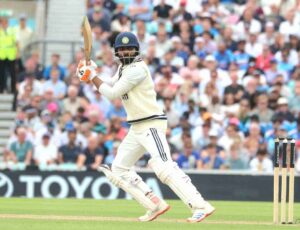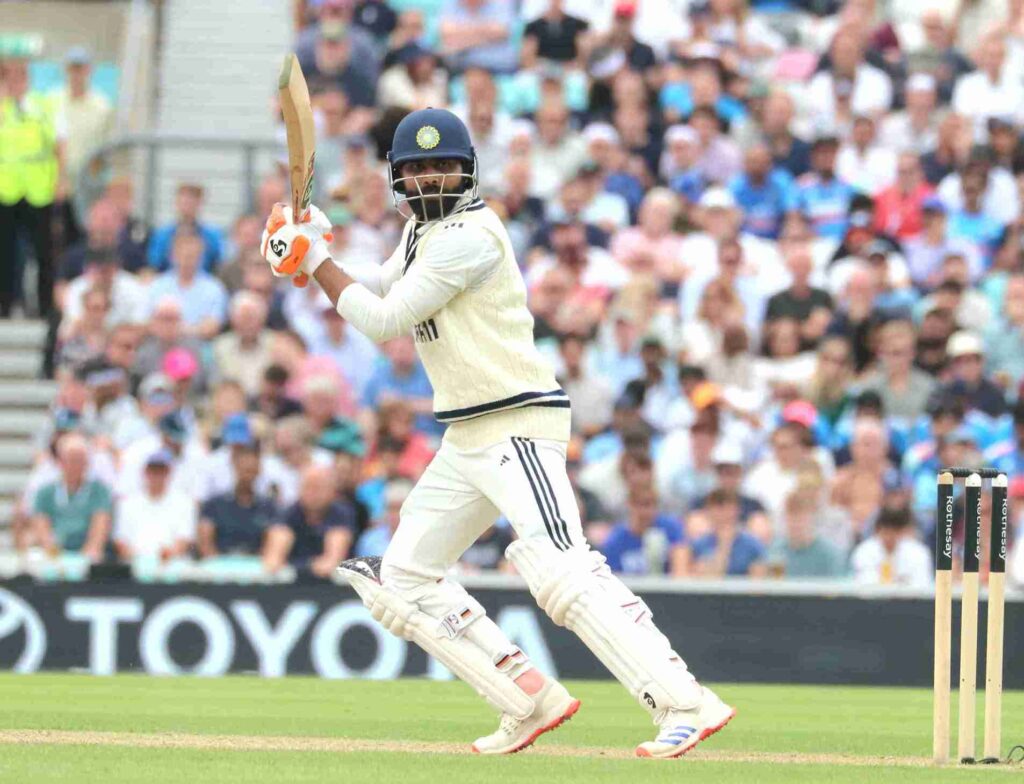
Trisha Ghosal in London
The scoreboard rarely tells the full story. It highlights centuries and five-fors, towering sixes and fiery spells. But amid the fire and flair, it sometimes forgets the backbone, the one who holds things together when it threatens to fall apart. In the India–England Test series of 2025, Ravindra Jadeja has been that backbone.
At No.6 or lower, in foreign conditions, Jadeja has quietly mounted a historic campaign; 516 runs, six scores above 50, and an unbeaten century. It’s not just a career-best series; it’s one for the Test match annals. Only Sir Garfield Sobers and Wasim Raja have come close to such consistency this lower down the order in away series. That Jadeja now sits among these legends tells you everything about how extraordinary this has been.
It didn’t begin that way. At Headingley, his 11 and 25* seemed inconsequential to the result, but even there, 24 of those 36 runs came in the company of tailenders. It was a whisper of what was to come. From Edgbaston onwards, the tide turned, and Jadeja began scripting chapters. An 89 and a 69* at Edgbaston. A vital 72 and 61* at Lord’s. Then came the series-defining 107* at Old Trafford, surviving tricky conditions after a dropped catch on 0, to save India a Test they were on the brink of losing.
The pattern was clear, every time India lost wickets, it was Jadeja who stabilised the innings. Every time the tail needed shepherding, he transformed into an experienced general. Every time the opposition sensed vulnerability, he quietly stitched together partnerships that would make the difference between defeat and a draw, or between a low total and a competitive one.
Let’s put the numbers in perspective. Jadeja is now the highest run-scorer for India at No.6 or lower in a Test series, beating the likes of VVS Laxman, Ravi Shastri, and Rishabh Pant. He also holds the record for most fifty-plus scores from No.6 or below in a series in England, six in total, beating the previous best by Sobers in 1966.
He’s been part of two double-century partnerships, one 150-plus and three fifty-plus stands. These aren’t just numbers, they’re acts of resistance that repeatedly turned the tide for India. In the third Test at Lord’s, after the top order collapsed, he built a bridge with Nitish Reddy, Siraj, and Bumrah to take India inches from an improbable win. While India fell short by just 22 runs, one cannot ignore Jadeja’s efforts. At The Kia Oval, when India were 189/4, he stitched a vital 53 to boost the lead.
The sword celebration after his milestones has become a symbol of defiance, precision, and pride. But what the gesture doesn’t show is the mental fortitude behind it: the willingness to stay patient when flashier names dominate headlines, the grit to play second fiddle, and the maturity to adapt to the moment.
While Gill dazzled with fluency, Rahul ground out tough runs, Pant threw punches, and Washington Sundar played his cameos, it was Jadeja who stood guard. His innings may not always have had the glamour, but they had the guts. And in Test cricket, guts often outshine glamour.
This wasn’t a man in the twilight of his career trying to hang on. This was Jadeja 2.0, the complete cricketer. A left-arm spinner trusted to plug the run flow on flat English decks, and a left-handed batter stepping up when India needed saving.
In a series that has seen the top four scorers all being Indian, Jadeja sits right there, rubbing shoulders with openers and stroke-makers, but doing it all from No.6 or lower. The quiet revolution he’s led may not have always made headlines, but it has certainly made history.
Ravindra Jadeja—the sword that not only cut deep into England’s bowling, but etched his name into cricket’s record books.
For More Sports Related News: Follow RevSportz




